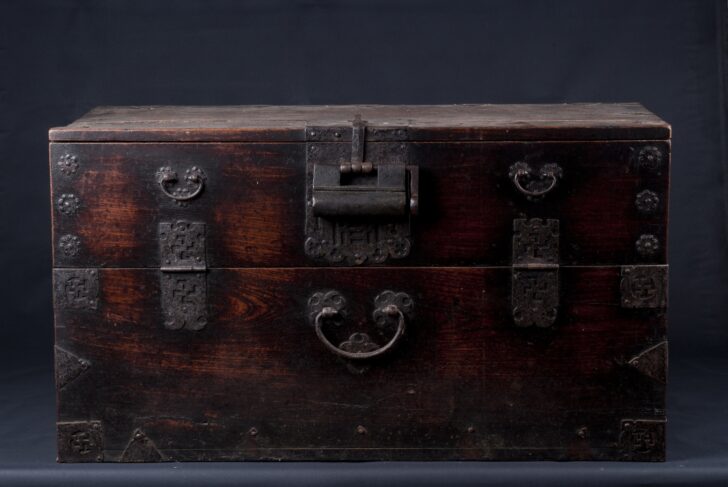Namhae Chest
Korean

Description
Recent Acquisitions Part II
March 31-August 5, 2012
Namhae chest
Korea
Joseon Period (1392–1910)
mid-19th century
Zelkova wood, iron fittings
Museum purchase made possible by the Margaret Watson Parker Fund, 2009/2.90
Subject Matter:
Called a bandaji or “half-closing chest” because it is accessed by an upper front panel that is hinged and kept closed by a latch at the top center, this was the most common type of chest used in Korea for the storage of clothing or books. In Korean homes in this period, people sat on mats and slept on cotton-stuffed mattresses on floors heated by a radiant under-floor system called ondol. During the day, bedding was cleared and stacked up on top of the bandaji, so these sturdy chests came to be known as blanket chests in the West.
Physical Description:
All parts of this chest, including the back, were made from solid zelkova planks, a luxury wood related to elm but with a more pronounced grain. This specimen has escaped aggressive cleaning with modern compounds and retains its original patina. The dovetail joints between the lower front panel and sides and the back and side panels are superbly wrought. The iron lock plate in the middle of the front is fashioned into an auspicious character, bok (good fortune). The rectangular iron hinges and square supporting corner brackets are fashioned into Buddhist swastika patterns. The four arms of each swastika radiate out from the center like the spokes of a wheel, symbolizing the rotation of the universe around the cosmic Buddha.
This chest was kept in a lady’s quarter (anbang ) to store clothes. Marks left on the inner surface indicate that the chest once contained a shelf. The side panels, back panel, and bottom panel were joined by finger joints, while the side panels and top plate were joined by butt joints. To the left and right sides of the door panel, three chrysanthemum-shaped studs are attached in order to conceal the holes made from nails that join the panels to internal struts. Pepper leafshaped Square brackets or diamond-shaped brackets are wrapped around the borders of the bottom panel. Brackets with swastika designs are found at each corner of the lower front panel. The arrangement of square brackets between the pepper-leaf-shaped brackets is a characteristic of chests produced in the areas of Namhae-gun.
[Korean Collection, University of Michigan Museum of Art (2017) p. 272]
Usage Rights:
If you are interested in using an image for a publication, please visit https://umma.umich.edu/request-image/ for more information and to fill out the online Image Rights and Reproductions Request Form.